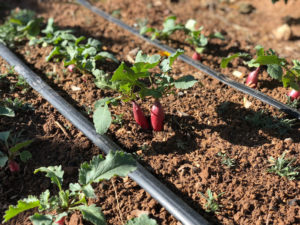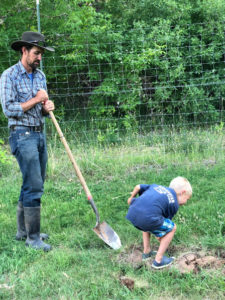The purpose of life
As I’ve described, bees are fascinating little creatures. But, the purpose behind their lives is pretty simple. Essentially, the bee’s existence boils down to the simple purpose of survival. From the bee’s perspective, there are three key steps to ensure survival.
- Protect/Defend the Hive
- Procreate
- Store Food for Periods of Scarcity
Bee’s never really make it past that “physiological needs” level in Maslow’s Hierarchy. One of the fascinating things about bees is their ability to support these needs through a community-like structure of relationships within the colony. Each bee has a specific function within the community, and the bees have incredible and mysterious ways of communicating with one another. It is their “oneness” that allows them to survive. There is no life for a maverick bee. Indeed, a lone bee is a dead bee.
There are incredible stories to be told within a community of bees. Everyone from the Queen to the eclectic mix of workers to the drones serve unique purposes within the colony. And, each experiences their own distinctive, and sometimes tragic, adventure related to the survival of the community. I’m excited to observe and share some of those stories over the next few months, and this week we start from the beginning with the birth of a bee.
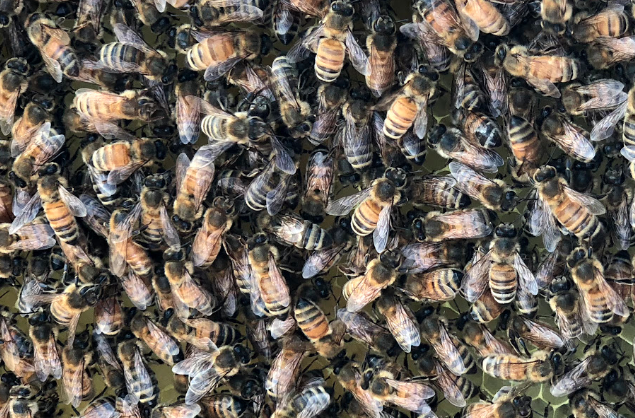
Hexagonal Cells - like a yurt, tipped on its side
In past posts I’ve shared pictures and descriptions of what the bees have been building. The comb is a double-sided web of interconnected hexagonal cells. These cells serve two of the three purposes outlined above. They facilitate procreation and they serve as space for food storage. Hence, the first thing the bees started doing after being unceremoniously dumped into what amounts to little more than a funny-shaped box was to start building comb. Bees produce wax to build the comb of identically shaped hexagonal cells. Why hexagons? Because they are the most efficient use of space and labor. Check out this NPR article if you’re curious why triangular, square or circular doesn’t make more sense.
As you see in the picture below, beeswax on fresh combs is white in color. The color gradually changes from white, to yellow, to a dark brown as the comb is used for brood, honey and pollen storage. Another noticeable feature of new comb in a top-bar hive is it’s heart-like shape. When left to their own devices, bees will always start their comb with this shape and build outward to fill whatever space they are in.
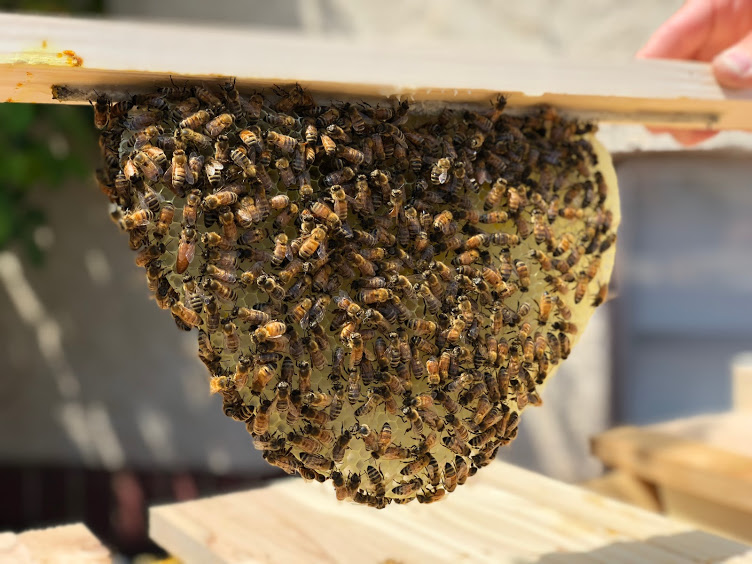
Reproduction First
The whole story of bee reproduction is pretty remarkable. I don’t feel nearly qualified to speak to the entire process, so I’m going to stick to the steps I’ve observed. Obviously, the queen is a central figure in reproduction. After being specially nurtured by nurse bees and taking a once-in-a-lifetime mating flight, the queen commits nearly the entirety of her life to one task…laying eggs.
As you can see in the picture above, the queen hangs out on comb and moves from cell to cell laying a single egg in each one. She’s mother to the entire colony, but she doesn’t have much in the way of “motherly instincts.” After laying an egg she simply moves on and leaves it to her tribe of nurse bees to care for all of the eggs she lays. With this singular focus, the queen lays upwards of 2,000 eggs each day.
It’s a good thing she lays that many, especially early in the life of a colony. The average worker bee lives around four months. And, after a tumultuous transition from hive to box with a queen you’ve never met to a new hive box in the rain, several additional bees sadly die. A new colony’s population starts out on a precipitous downward trajectory, so it’s no wonder the bees are anxious to get comb established and the queen out of her cage so she can start laying some eggs.
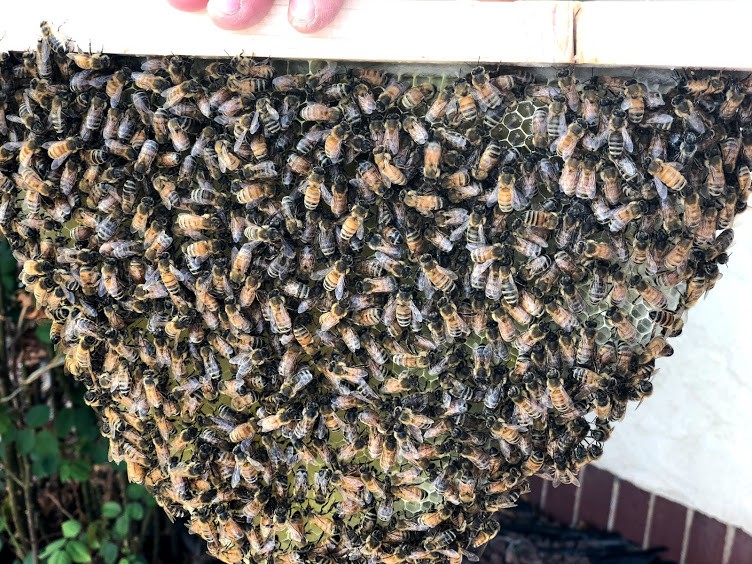
The Development of a Bee
As mentioned before, the queen has a singular role in reproduction, laying eggs. Once her task is complete, a coordinated team of nurse bees care for the eggs as they develop into larvae, then pupae, and eventually hatch as fully grown bees. These nurse bees have a remarkable level of responsibility and discretion in how they care for the next generation. It is not the queen who determines whether a bee develops to be part of her team as another worker, or whether a bee develops to be a rival queen. That is the determined by how the nurse bees care for the egg and larvae. I may write a whole post on the process someday, but for now, let’s focus on those three stages of bee development.
- Egg – It takes 3 days for an egg to develop in a cell before maturing into a larvae. During this phase, the worker bees work diligently to keep the cell the egg is in clean, to keep predators (i.e. mites) from getting into the egg cells and to provide temperature regulation of the hive.
- Larvae – Depending on whether the bee is maturing into a worker, drone or queen, the duration of time spent as a larvae can vary slightly, but on the whole a bee generally spends approximately 6 days in the larvae stage of development. During this phase the nurse bees bring royal jelly and honey directly to each cell and feed the larvae. It’s probably the most labor intensive period for the nurse bees (think infant and toddler years for humans).
- Pupae – As the larvae mature into Pupae, the worker bees cap the cells and allow the pupae to feed themselves on the honey left in the cell. Again, the time can vary slightly, but in general bees spend 9 days as capped pupae, or “capped brood” as it is commonly referred to. See all of those capped cells in the middle of the comb shown below? That’s freshly capped brood.
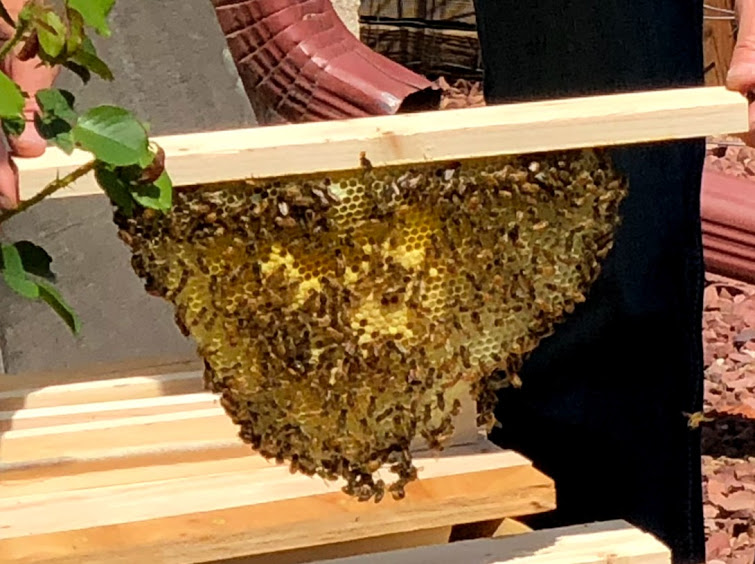
3+6+9=18 Days!
So, if you do the math, it’s 18 days from the time the queen lays an egg to the time that egg turns into a full-fledged contributing member of the colony. 18 days seems like a pretty short reproductive cycle, but remember, these bees have already been through a wild course of events. 18 days without replacing any of the dead is a rough stretch. So, now you understand why I was so anxious to get into my hive for my three-week inspection. I’ve seen the bees establishing their hive and building up some defenses. I’ve seen them finding and stashing away some small stores of food. Now I finally get to see if they’re having any success in that third priority of life, procreation.
Take a look at the image below, and you’ll see what I found. The comb has been built out to fill nearly the entirety of the space they have available. The capped brood has darkened, a sure sign the pupae are growing. There’s still some honey being stored as a snack for the worker bees and as a first meal for the hatched brood (honey is in the cells capped with white wax at the top, see the difference between the capped brood and the capped honey?). And, there’s even a few empty cells in the middle of the capped brood.
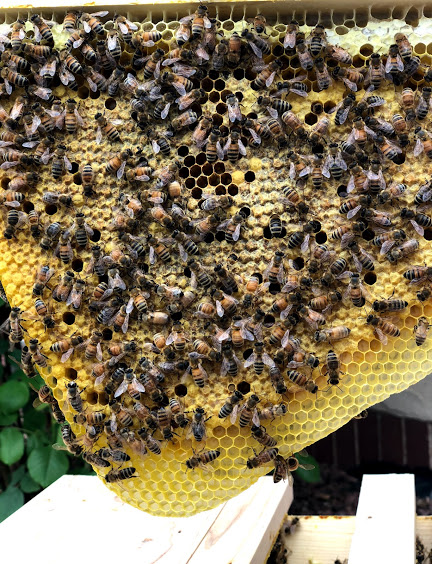
But wait! Do you see what I see? Here, take a little closer look.
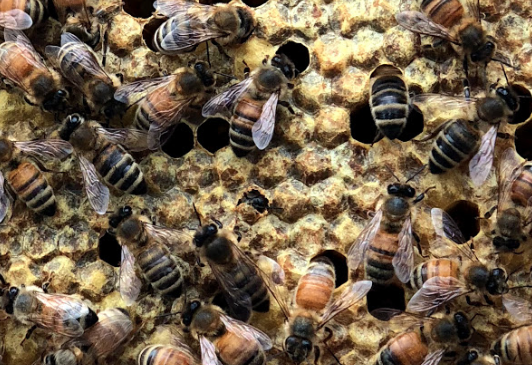
See those eyes peaking out of the cell in the middle of the picture? That’s a bee just starting to chew her way through the wax capping of the cell. In just a few moments she will hatch. Reproduction! It’s happening! And perhaps the most amazing thing of all, as soon as she hatches from the cell, she will find a quick sip of honey and step immediately into her role as a worker bee. Helping to clean cells, draw comb, nurse larvae, store honey, feed the queen, and perhaps eventually graduate to forage for nectar and pollen and defend the hive. Just another bee joining a colony of thousands in the singular purpose of survival.

